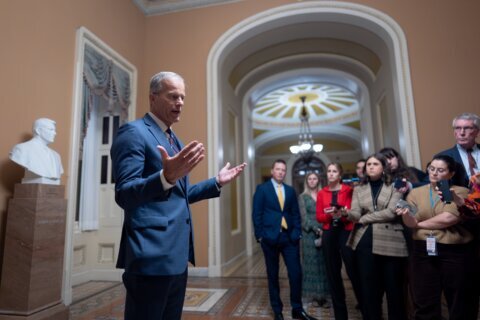(CNN) — The current drama should feel so familiar:
► A deadline looms for a must-pass, stopgap funding bill to avoid a government shutdown.
► Former President Donald Trump is encouraging Republicans to embrace a shutdown if they can’t get Democrats to agree to add controversial immigration-related language – this time, related to noncitizens voting – into the spending bill.
►Republicans don’t have the votes to execute Trump’s command in the House, where they have the majority, and much less in the Senate, where Democrats are in control.
Variations on that pattern have been repeated through multiple funding fights to the point where most Americans’ eyes probably glaze over at talk of a possible government shutdown, a serial threat that hasn’t come to be since Trump was in the White House and Republicans controlled both the House and the Senate.
Get the latest on the current state of play from CNN’s Capitol Hill team.
Setting all of that aside, for just a moment, it’s worth looking at why the funding process allows for the threat of a government shutdown every year and sometimes multiple times during the course of a year.
OK, how are things supposed to work?
The Constitution requires that the government only spend money that comes through “appropriations made by law.” Laws must be passed by both the House and Senate and signed by the president. But we’re talking a lot of money – $1.7 trillion in annual discretionary spending in the most recent fiscal year.
Lawmakers in the House and Senate divide up the funding of the government into 12 different appropriations bills. Committees in the House and Senate work to draft appropriations.
The full House and Senate are then supposed to consider these bills in turn, reconcile their differences and send the final product to the president. This work is supposed to be completed by September 30 since the government’s fiscal year begins on October 1.
How many of these regular appropriations bills were passed into law this year?
Zero.
The House, to its credit, passed an initial version of five of the 12 appropriations bills. The Senate didn’t pass any, so none of the appropriations bills came anywhere close to being signed into law.
That doesn’t mean lawmakers didn’t do any work on the spending bills. Appropriations committees in both the House and Senate did pass versions of all but one bill, and the versions passed in the Senate committees were all passed with some bipartisan support. Even if the appropriations bills don’t pass, the work of these committees can ultimately be reflected in spending bills that do pass.
When was the last time Congress passed a single regular appropriations bill on time?
It’s been years.
Lawmakers haven’t passed a single appropriations bill on time and sent it to the president’s desk since 2019, when they sent five. That’s the same year of the most recent partial government shutdown, by the way.
The 2019 fiscal year was an anomaly. Lawmakers routinely fail to pass any appropriations bills at all. In the years leading up to 2019, lawmakers passed one single appropriations bill on time in 2017 and one in 2010.
In the decades before that, they would routinely pass a few appropriations bills, but in the nearly half-century this process has been in place, they’ve only really completed the work in four years: 1977, 1989, 1995 and 1997. In only one other year did they even get to more than half of the appropriations bills.
What happens when Congress can’t pass the normal spending bills?
Lawmakers pass a temporary funding bill, known as a “continuing resolution,” or CR. Sometimes these bills are referred to as “stopgap” measures. They keep the government running until, frequently, all of the appropriations are wrapped into a massive omnibus that is passed months after the fiscal year starts.
What’s wrong with this system?
Continuing resolutions usually just buy time. Rather than implement funding for the new year, they simply extend the previous year’s funding. That’s better than a gap in funding, but certainly not the most efficient way to run a massive government.
A 2022 report by the Government Accountability Office identified inefficiencies in the process, but also found that the federal bureaucracy is used to the uncertainty built into the system.
But there’s another element to consider. More and more, consideration of a CR comes at the last minute, along with fears of a government shutdown, or lapse in funding, such as the one Trump suggested Republicans embrace to force consideration of their bill requiring proof of citizenship to register to vote.
The distraction of planning, year after year, for a shutdown is a major inefficiency. House Speaker Mike Johnson, according to CNN’s Capitol Hill team, has said he thinks Trump now understands that Republicans don’t have the votes to make it happen, but Trump has not endorsed a simple extension of funding.
Similarly, when lawmakers get around to the large omnibus spending bill that ties appropriations together, they’re frequently asked to vote days after these massive bills are introduced. The last-minute nature is part of what pressures them to get things done.
How often does Congress need extra time to fund the government?
Pretty much every single year. The current budget process has been in place since the late ’70s. In those 47 fiscal years, there has been at least one CR in all but three fiscal years. The most recent fiscal year in which there was no CR was 1997, according to the Congressional Research Service.
Continuing resolutions are essentially part of the process at this point. Many of the numbers in this story come from that CRS report.
How long do these temporary funding bills last?
They can be enacted for as little as a day or for much longer. It just depends on the year and the politics of the day.
The CRS report averaged the 200 continuing resolutions that have been put in place since the 1977 fiscal year and found that CRs fund all or part of the government for an average of 137 days, or about a third of the year. In some years, Congress lurches from CR to CR until well into the spring.
For the most recent fiscal year, which was supposed to begin last October, President Joe Biden didn’t sign a yearlong funding bill until late March.
Why does it take so long?
There’s a lot of politicking that goes on around these spending bills each year.
It was a standoff over last year’s spending bill that cost former House Speaker Kevin McCarthy his position. His willingness to pass a short-term funding bill – a CR – with help from Democrats sparked a rebellion from a few hard-line Republicans, even though his ouster frustrated most GOP lawmakers.
It took Republicans days to pick Johnson.
Johnson ultimately hatched a similar spending deal to one McCarthy had been working on, but not before multiple, additional CRs kept the government running.
He needed Democrats to keep the government open. Johnson will almost certainly need help from Democrats again this year after Trump encouraged Republicans to embrace a shutdown without an added-on voting bill.
What happens if there’s a shutdown?
The term “shutdown” is also something of a misnomer. Lapses in funding are a bad way to do business, and they can delay paychecks for federal workers and temporarily shutter some government services. But the most recent shutdowns have affected only portions of the government, and they are usually short-lived.
The 2018-2019 partial shutdown, the longest in history at five weeks, did not affect all federal departments and reduced economic output by $11 billion, according to the Congressional Budget Office.
Shutdowns can also have real political consequences. Sen. Mitch McConnell, the outgoing Senate minority leader, is among the Republicans warning that a shutdown right before the November election would be a very bad idea.
The-CNN-Wire
™ & © 2024 Cable News Network, Inc., a Warner Bros. Discovery Company. All rights reserved.







